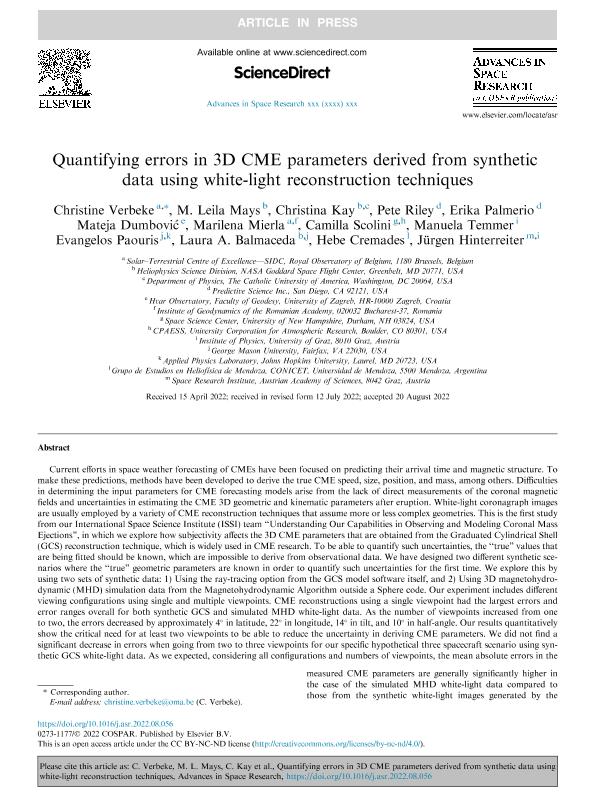Mostrar el registro sencillo del ítem
dc.contributor.author
Verbeke, Christine
dc.contributor.author
Mays, M. Leila
dc.contributor.author
Kay, Christina
dc.contributor.author
Riley, Pete
dc.contributor.author
Palmerio, Erika
dc.contributor.author
Dumbović, Mateja
dc.contributor.author
Mierla, Marilena
dc.contributor.author
Scolini, Camilla
dc.contributor.author
Temmer, Manuela
dc.contributor.author
Paouris, Evangelos
dc.contributor.author
Balmaceda, Laura Antonia

dc.contributor.author
Cremades Fernandez, Maria Hebe

dc.contributor.author
Hinterreiter, Jürgen
dc.date.available
2023-07-20T18:48:41Z
dc.date.issued
2022-08
dc.identifier.citation
Verbeke, Christine; Mays, M. Leila; Kay, Christina; Riley, Pete; Palmerio, Erika; et al.; Quantifying errors in 3D CME parameters derived from synthetic data using white-light reconstruction techniques; Elsevier; Advances in Space Research; 70; 4; 8-2022; 1-20
dc.identifier.issn
0273-1177
dc.identifier.uri
http://hdl.handle.net/11336/204700
dc.description.abstract
Current efforts in space weather forecasting of CMEs have been focused on predicting their arrival time and magnetic structure. To make these predictions, methods have been developed to derive the true CME speed, size, position, and mass, among others. Difficulties in determining the input parameters for CME forecasting models arise from the lack of direct measurements of the coronal magnetic fields and uncertainties in estimating the CME 3D geometric and kinematic parameters after eruption. White-light coronagraph images are usually employed by a variety of CME reconstruction techniques that assume more or less complex geometries. This is the first study from our International Space Science Institute (ISSI) team “Understanding Our Capabilities in Observing and Modeling Coronal Mass Ejections”, in which we explore how subjectivity affects the 3D CME parameters that are obtained from the Graduated Cylindrical Shell (GCS) reconstruction technique, which is widely used in CME research. To be able to quantify such uncertainties, the “true” values that are being fitted should be known, which are impossible to derive from observational data. We have designed two different synthetic scenarios where the “true” geometric parameters are known in order to quantify such uncertainties for the first time. We explore this by using two sets of synthetic data: 1) Using the ray-tracing option from the GCS model software itself, and 2) Using 3D magnetohydrodynamic (MHD) simulation data from the Magnetohydrodynamic Algorithm outside a Sphere code. Our experiment includes different viewing configurations using single and multiple viewpoints. CME reconstructions using a single viewpoint had the largest errors and error ranges overall for both synthetic GCS and simulated MHD white-light data. As the number of viewpoints increased from one to two, the errors decreased by approximately 4° in latitude, 22° in longitude, 14° in tilt, and 10° in half-angle. Our results quantitatively show the critical need for at least two viewpoints to be able to reduce the uncertainty in deriving CME parameters. We did not find a significant decrease in errors when going from two to three viewpoints for our specific hypothetical three spacecraft scenario using synthetic GCS white-light data. As we expected, considering all configurations and numbers of viewpoints, the mean absolute errors in the measured CME parameters are generally significantly higher in the case of the simulated MHD white-light data compared to those from the synthetic white-light images generated by the GCS model. We found the following CME parameter error bars as a starting point for quantifying the minimum error in CME parameters from white-light reconstructions: Δθ (latitude)=6°-3°+2°, Δϕ (longitude)=11°-6°+18°, Δγ (tilt)=25°-7°+8°, Δα(half-angle)=10°-6°+12°, Δh (height)=0.6-0.4+1.2 R⊙, and Δκ (ratio)=0.1-0.02+0.03.
dc.format
application/pdf
dc.language.iso
eng
dc.publisher
Elsevier

dc.rights
info:eu-repo/semantics/openAccess
dc.rights.uri
https://creativecommons.org/licenses/by-nc-nd/2.5/ar/
dc.subject
CORONAL MASS EJECTIONS
dc.subject
REMOTE-SENSING OBSERVATIONS
dc.subject
SOLAR CORONA
dc.subject.classification
Astronomía

dc.subject.classification
Ciencias Físicas

dc.subject.classification
CIENCIAS NATURALES Y EXACTAS

dc.title
Quantifying errors in 3D CME parameters derived from synthetic data using white-light reconstruction techniques
dc.type
info:eu-repo/semantics/article
dc.type
info:ar-repo/semantics/artículo
dc.type
info:eu-repo/semantics/publishedVersion
dc.date.updated
2023-06-30T13:11:24Z
dc.journal.volume
70
dc.journal.number
4
dc.journal.pagination
1-20
dc.journal.pais
Países Bajos

dc.journal.ciudad
Amsterdam
dc.description.fil
Fil: Verbeke, Christine. Royal Observatory Of Belgium (rob);
dc.description.fil
Fil: Mays, M. Leila. NASA Goddard Space Flight Center. Heliophysics Science Division; Estados Unidos
dc.description.fil
Fil: Kay, Christina. NASA Goddard Space Flight Center. Heliophysics Science Division; Estados Unidos. The Catholic University of America; Estados Unidos
dc.description.fil
Fil: Riley, Pete. Predictive Science Inc.; Estados Unidos
dc.description.fil
Fil: Palmerio, Erika. Predictive Science Inc.; Estados Unidos
dc.description.fil
Fil: Dumbović, Mateja. University of Zagreb; Croacia
dc.description.fil
Fil: Mierla, Marilena. Institute of Geodynamics of the Romanian Academy; Rumania. Royal Observatory of Belgium; Bélgica
dc.description.fil
Fil: Scolini, Camilla. University of New Hampshire; Estados Unidos. University Corporation for Atmospheric Research; Estados Unidos
dc.description.fil
Fil: Temmer, Manuela. University of Graz; Austria
dc.description.fil
Fil: Paouris, Evangelos. George Mason University; Estados Unidos. University Johns Hopkins; Estados Unidos
dc.description.fil
Fil: Balmaceda, Laura Antonia. Consejo Nacional de Investigaciones Científicas y Técnicas. Centro Científico Tecnológico Conicet - San Juan. Instituto de Ciencias Astronómicas, de la Tierra y del Espacio. Universidad Nacional de San Juan. Instituto de Ciencias Astronómicas, de la Tierra y del Espacio; Argentina. George Mason University; Estados Unidos. NASA Goddard Space Flight Center; Estados Unidos
dc.description.fil
Fil: Cremades Fernandez, Maria Hebe. Consejo Nacional de Investigaciones Científicas y Técnicas. Centro Científico Tecnológico Conicet - Mendoza; Argentina. Universidad de Mendoza; Argentina
dc.description.fil
Fil: Hinterreiter, Jürgen. University of Graz; Austria
dc.journal.title
Advances in Space Research

dc.relation.alternativeid
info:eu-repo/semantics/altIdentifier/url/https://www.sciencedirect.com/science/article/pii/S027311772200792X
dc.relation.alternativeid
info:eu-repo/semantics/altIdentifier/doi/http://dx.doi.org/10.1016/j.asr.2022.08.056
Archivos asociados
